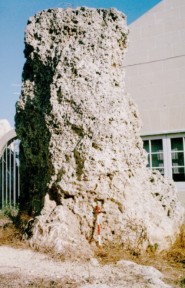


Three hypothesis are brought forward to explain for the existence of Menhirs on the Maltese Islands.
The first suggests that Menhirs are the last remains of Megalithic Temples. This claim is legitimized by excavations carried out around what was known as the Skorba Menhir - this ‘Menhir’ turned out to be the upper part of an upright monolith in the Ggantija phase Temple at the site. Temple period pottery has also been noted near tal-Hofra Menhir at Gudja. It is the opinion of the present author that menhirs should be attributed to this culture.
Menhirs have in more than one country been linked to the Bronze Age. It is in fact interesting to note that upright stones similar to the local Menhirs are claimed to stand in the Apulia region in Italy, close to the Otranto Dolmens which are in themselves similar to those on the Maltese Islands.
A final explanation for Menhirs is that these stones could have been produced by natural phenomena- the alleged menhir near the Migbha on Xemxija Hill is probably the most typical example.
Today eight standing stones are recognized as menhirs (Evans 1971, Trump 1990), their location confined to the southern part of the larger two islands of the archipelago and generally located on gentle slopes. Other than for the standing stone at Qala found at an altitude of a hundred and twenty metres, the other examples were erected on grounds with an altitude between twenty to ninety metres.
The constituent material is either coralline (Qala, Ta’
Ghammar) or globigerina (Kirkop, Wied il-Ghajn) limestone, the choice of
material dictated by the availability of stone in the vicinity of the monument
. Unlike foreign examples, no significant orientation has been linked to
the monoliths, and local Menhirs are typically irregular in shape with
no signs of finishing. The tallest menhir recorded remains that at Qala
with a height of 3.30m. A number appear to bear the marks of the extensive
Christianisation prevalent on the islands during the last five hundred
years.



GOTO HOMEPAGE
Contact author by E-Mail